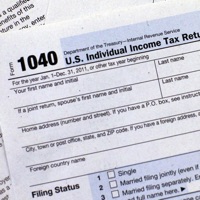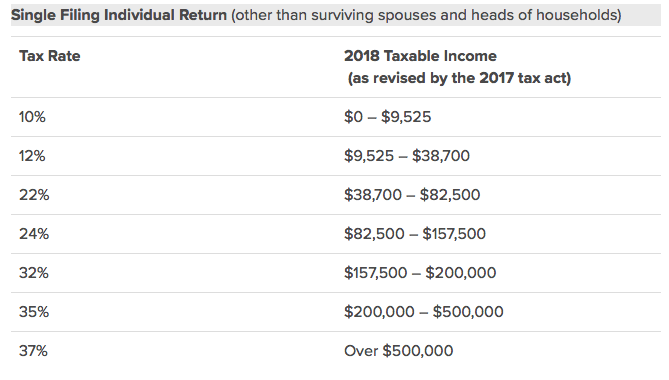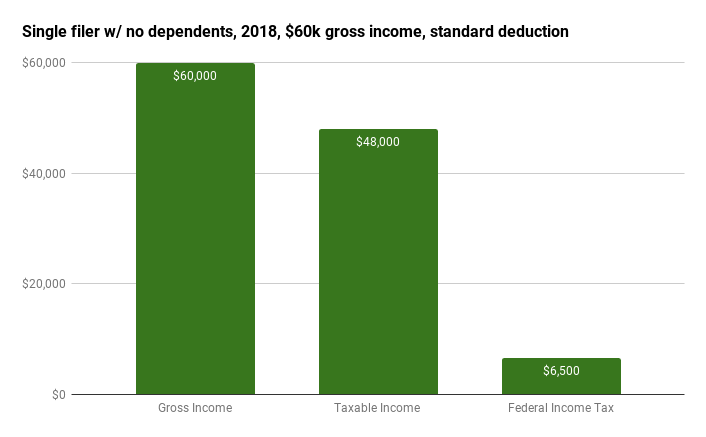
The Tax Cuts and Jobs Act (TCJA) changed up the personal income tax brackets, exemptions, and deductions. Here is an updated graphical breakdown of a simple scenario for a single filer with no dependents in Tax Year 2018. I’ll try to illustrate the relationship between gross income, taxable income, marginal tax rate, and effective tax rates. See also my previous post 2018 Income Tax Breakdown (Married w/ 1 Child).
2018 federal income tax rates for single filers. Taken from the official IRS tax tables (source):

The following changes also apply for Tax Year 2018:
- The personal exemption deduction is now gone ($0), from $4,050 in 2017.
- The standard deduction for single taxpayers and married taxpayers filing separately rises to $12,000 from $6,350.
- The standard deduction for married taxpayers filing joint returns rises to $24,000 from $12,700.
- The standard deduction for heads of household rises to $18,000 from $9,350.
- The Child Tax Credit was expanded with higher income phaseout limits and is now worth up to $2,000 per qualifying child.
Let’s say your individual gross income is $60,000 a year. You are single with no dependents, aged 64 and under. You are an employee that receives W-2 income only (i.e. you are not self-employed). You don’t have any additional income sources like interest, capital gains, rents, etc. You don’t have any extra deductions like IRA/401k contributions or mortgage interest. You live in a state with no state income tax. We will ignore any state or local income taxes.
Gross income. Let’s start with your annual $60,000 gross income. There are no personal exemptions anymore. You do get the larger standard deduction which is $12,000 for single filers in 2018. Since you don’t have a lot of itemized deductions, you fall back onto the standard deduction.

The first 12,000 of your gross income is not taxable. Without doing anything special at all, your $60,000 in gross income is now only $48,000 in taxable income after personal exemptions and the standard deductions.
The first $9,525 of taxable income is subject to a 10% tax rate. Shave off 10% of $9,525 and put that on your tax bill ($952.50). The remaining $38,475 of taxable income is moved onto the next tax bracket.
The next $29,175 in taxable income is subject to a 12% tax rate. So we take 12% of $29,175 ($3,501) and add that to the existing $952.50. The tax bill is now $4,453.50. The remaining $9,300 of taxable is moved onto the next tax bracket.
The next $43,800 in taxable income is subject to a 22% tax rate. However, we only have $9,300 left. So we take 22% of $9,300 ($2,046) and add that to the existing $4,454 (let’s round up that dollar). The total tax bill is now $6500.
In this example, this 22% is your marginal tax bracket. If you earned another $1, it would be taxed at this marginal rate of 22%.

Payroll taxes. These aren’t technically federal income taxes, but you must pay a Social Security tax (OASDI) of 6.2% and Medicare payroll tax (HI) of 1.45% of your gross income. That’s $3,720 a year for Social Security and $870 a year for Medicare. (Your employer pays the same amount.)
Overall effective tax rate. You paid $6,500 in federal income taxes on $60,000 of gross income, for an overall effective tax rate of 10.8%. You also paid 7.65% in payroll taxes.
The same single filer in 2017 would have paid $8,139 in federal income taxes on $60,000 of income, for an average or overall effective tax rate of 13.6%.
 The Best Credit Card Bonus Offers – March 2024
The Best Credit Card Bonus Offers – March 2024 Big List of Free Stocks from Brokerage Apps
Big List of Free Stocks from Brokerage Apps Best Interest Rates on Cash - March 2024
Best Interest Rates on Cash - March 2024 Free Credit Scores x 3 + Free Credit Monitoring
Free Credit Scores x 3 + Free Credit Monitoring Best No Fee 0% APR Balance Transfer Offers
Best No Fee 0% APR Balance Transfer Offers Little-Known Cellular Data Plans That Can Save Big Money
Little-Known Cellular Data Plans That Can Save Big Money How To Haggle Your Cable or Direct TV Bill
How To Haggle Your Cable or Direct TV Bill Big List of Free Consumer Data Reports (Credit, Rent, Work)
Big List of Free Consumer Data Reports (Credit, Rent, Work)
“The next $43,800 in taxable income is subject to a 25% tax rate. However, we only have $9,300 left. So we take 22% of $9,300 ($2,046) and add that to the existing $4,454 (let’s round up that dollar).”
Not following this, where did the 22% come from if the tax rate is 25%?
Thanks, that 25% is a typo; should be 22% as indicated in the tax bracket chart. The calculations are otherwise correct.
“The next $43,800 in taxable income is subject to a 25% tax rate”. The rate in the table is 22%. The sentence in bold has a typo.
Thanks, that 25% is a typo; should be 22% as indicated in the tax bracket chart. The calculations are otherwise correct.
Thank you Jonathan for this example. Somebody please forward it to Chuck Schumer. I am so tired of his narrative that the TCJA does nothing for the middle class. This ain’t crumbs Nancy.
We can talk about the numbers and how it affects folks differently across different income levels, but let’s not get into political name-calling. I believe that I read a study that 80% of taxpayers should pay less, 15% would pay the same, and 5% would pay more. TCJA does limit certain itemized deductions whereas this example assumes the standard deduction (which applies to most low- and below median-income earners).
Jonathan,
Are you going to use any software to compute, file taxes? (I used Turbotax, but it’s a bit spendy, otherwise there is AARP in Oregon, that help/does your taxes for free). By the way, I’m one of the volunteers for VITA here, the software is not on par w/ Turbotax, less intuitive, less automation in figuring your tax breaks, but it’s free.
Don’t know if you’d seen this H&R Block and IBM Watson https://www.hrblock.com/lp/fy17/hrblock-and-watson.html
Any thoughts?
By anybody’s definition, I am middle class. However, in 2018 I paid $3,500 more in federal income taxes than in 2017 due to the cap on itemized deductions. After a lifetime of working, no pension plan awaits so that $3,500 cuts into my self-funded retirement. The reality of it is the new tax laws sacrifice people such as myself to make it possible for others to enjoy a bigger refund. I doubt I’m part of the unfortunate 5%; that number seems like propaganda to me.
Here’s what I think: according to the current administration, the “middle class” excludes anyone living on either coast; that is, the coasts that typically vote Democratic/Liberal.